A few tips apply to every fire bell—whether it’s used as a waterflow alarm, school bell, security aid, or fire alarm appliance
Fire bells have been a staple of the life safety industry for more than a century. And while they’ve helped save an untold number of lives, they’ve also found their way into school attendance systems, makeshift security systems, and even the “world’s loudest alarm clock.”
In this article, we look at fire bells, explaining a bit about electrical compatibility, noise levels, and even essential fire code requirements from the National Fire Protection Association (NFPA). To help fire professionals and those using fire bells in less conventional ways, we’ve split this article into two parts:
- Bare minimum knowledge: information on electricity and noise designed for non-experts (or a refresher for fire safety pros)
- Fire safety concerns: choosing a code-compliant fire alarm bell for use with a sprinkler or standpipe system (waterflow alarm) or fire alarm system (notification appliance)
Know which fire bells you need? Hop over to our collection of alarm bells and accessories.
A fire bell’s voltage and volume matter to fire professionals and non-experts alike
Fire bells go by a variety of names—alarm bell, fire bell, sprinkler bell, or gong bell—but in the end, there are two essential types:
- Electric bells. Simple wiring allows these to connect to buttons, switches, and control panels. Most work with security systems, fire alarm systems, or electronic devices (flow and pressure switches) that activate when water flows through a fire sprinkler system.
- Water-activated bells (water gongs or water motor gongs). These ring only when a supply of pressurized water passes through a pipe. They’re designed with specific fire safety uses in mind.
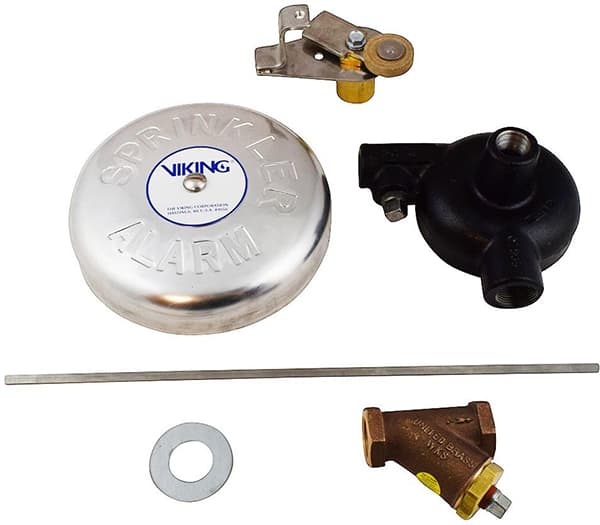
In this section, we’ll demystify voltage, bell size, and volume. If you’re familiar with these topics—and want to know more about fire safety applications, specifically—skip ahead to a more in-depth look at bells and NFPA code for fire alarm, sprinkler, and standpipe systems.
One warning before we go any further: if your building has a fire alarm system—and that system relies on fire bells to encourage evacuation—you probably can’t use fire bells for security, time-keeping, or other reasons. Different types of signals (evacuation, intrusion, and so on) need distinct sounds to help people hear the difference between a life-saving signal and something less essential.
Voltage is one of the most essential—and confusing—topics in fire bell selection
Voltage is key when choosing an alarm bell. Imagine wires as empty pipes, and electricity as water flowing through them. Voltage acts like water pressure: systems with higher voltage move electricity through wires more rapidly.
110 to 120 volts (called “high voltage” or “line voltage”) is standard throughout the United States. From toasters to computers, nearly any appliance that’s plugged into a wall socket relies on a 120-volt supply.
Some general guidelines on voltage can make selecting a fire bell easier. These aren’t hard-and-fast rules—and we’ll finesse them a bit below—but, in general, consumers should:
- Pick low-voltage bells—either 12 or 24 volts—when connecting to a control panel or a transformer (a device, often found with doorbells, that reduces voltage).
- Choose 120-volt bells when connecting directly to switches, buzzers, or a building’s power supply.
- Stick with alternating current (AC or VAC) if you’ll connect directly to a building’s wiring.
- Use a direct current (DC or VDC) fire bell if the device will rely on battery power or electronics with low-voltage output (like most control panels).
- Avoid connecting a low-voltage device to a high-voltage power source. Too much voltage can destroy sensitive electronic components, causing short circuits and overheating.
The specifics will vary: some control panels, for example, may use slightly different voltages, or may even operate on AC power. Always keep in mind that electricity is dangerous. Use common sense, follow any safety warnings provided, and, if you’re at all unsure about doing this yourself, don’t try it. Seek assistance from a qualified electrician.
Most fire bells are very, very loud—and the volume often (but not always) increases with the bell’s size
A bigger fire bell doesn’t always make more noise. From a few feet away, most are as loud as 80, 90, or even 100 decibels (dB). That’s somewhere between the noise produced by a garbage disposal and a lawnmower.
DIY-ers (and others using wall-mounted bells for reasons other than fire safety) can take a page from the fire protection world. Bells need to be louder than ambient sound levels to be heard.
We’ve looked at this topic in some depth before. Each ten-decibel increase represents a ten-fold increase in the sound’s power. An 80dB bell is ten times as loud as a 70db one, 90dB is ten times as loud as 80dB, and so on. A rule of thumb in fire protection is that the bell’s sound should be 15dB over average ambient noise levels.
Remember, though, that the volume heard will decrease as listeners get farther and farther away. A 96-decibel bell is only that loud from a fixed distance—usually ten feet. It’s roughly six decibels quieter each time that distance doubles (although the exact amount varies with the carpets, ceilings, and other materials featured in the room).
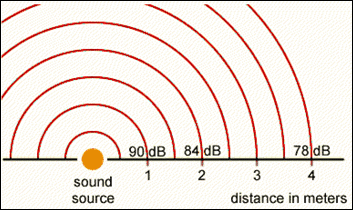
The numbers confirm common sense: louder bells can be heard over (much) longer distances
Let’s consider how loud a 96-decibel bell will be at various distances. If you take these figures—and compare them with the ambient noise levels in a given building—you’ll find that a high-decibel fire bell can be heard at great distances in all but the loudest rooms:
- 90dB at 20 feet
- 85 dB at 35.5 ft
- 80 dB at 63 feet
- 75 dB at 112 feet
- 70 dB at 200 feet
Compare that with typical ambient noise levels that are offered in table A.18.4.3 of NFPA 72: National Fire Alarm and Signaling Code (a volume of rules governing the installation of fire alarm systems). These averages are inexact—but they’re a good starting point, especially for consumers who use bells for other reasons.
- Businesses (~55dB ambient sound): a fire bell of 70dB or more is needed.
- Churches, restaurants, and theaters (~55dB ambient sound): 70dB or more needed.
- Grocery stores, department stores, and gas stations (~40dB ambient sound): 55dB or more needed.
- Hospitals, nursing homes, and prisons (~50dB ambient): 65dB or more needed.
- Industrial facilities (~80dB ambient): 95dB or more needed.
- Mechanical rooms (~85dB ambient): 100dB or more needed.
- Outdoor walkways (~40-70dB ambient): 55-85dB or more needed.
- Piers and water-surrounded structures (~40dB ambient): 55dB or more needed.
- Residential buildings (~35dB ambient): 50dB or more needed.
- Schools and universities (~45dB ambient): 60dB or more needed.
- Storage facilities (~30dB ambient): 45dB or more needed.
- Underground structures and windowless buildings (~40dB ambient): 55dB or more needed.
- Vehicles and vessels (~50dB ambient): 65dB or more needed.
Taking this one step further: a 96-decibel bell can be heard from 200 feet away in the “average” business or restaurant—and from even further away in quieter spaces like residential buildings or schools. Louder bells (or a greater number of them) may be needed in large industrial or mechanical spaces.
Note, however, that especially loud noises may cause permanent hearing damage. The National Institute for Occupational Safety and Health warns that more than 90 seconds’ exposure to 110-decibel sounds can be unsafe.
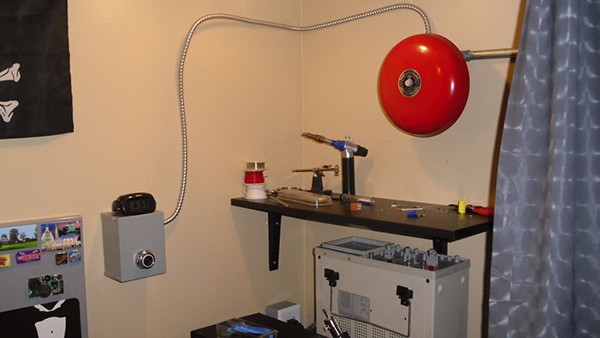
Fire bell design varies to account for different uses in fire safety
In this section, we’ll show how fire safety professionals use bells in two distinct ways:
- As waterflow alarms. Electronic fire bells connect to switches, called flow or pressure switches, that activate when water flows in a fire sprinkler or standpipe system. Alternatively, installers may use a device called a water motor gong that accomplishes the same task without electricity. Either way, the bell rings as water discharges from a hose or a fire sprinkler.
- To notify a building’s occupants or staff about a fire. These fire bells encourage people to evacuate during a potential fire (or get the attention of staff members tasked with facilitating a more discrete evacuation).
Local waterflow alarms, found with sprinkler and standpipe systems, will typically use a 120-volt bell or water motor gong unless there’s a fire alarm system in the building
Nearly every commercial building—and all but the smallest residential ones—must have a local waterflow alarm. The same is true for standpipe systems (excluding manual-dry types). The fire bells used to sound these alarms connect to the fire riser and may be electric (standard bells) or mechanical (water motor gongs).
Why have both kinds of fire bells?
- Water motor gongs help firefighters estimate the size of a fire. If the bell is ringing slowly, the supply of water may be running low; if the supply of water is running low, several fire sprinklers may have opened. Firefighters can then pump water into the system, listening for a change in the bell’s sound that indicates that the pressure to sprinkler heads has been increased.
- Electric bells are often the most inexpensive—and fully-featured—choice. They’re necessary for waterflow alarms serving preaction and deluge systems, which must activate when (electronic) sensors detect concerning levels of heat, smoke, or other indicators of a fire. They’re also a good choice when a building has a fire alarm system, since one flow or pressure switch can send a signal to a fire alarm control panel and sound the alarm.
These devices may or may not be connected to a fire alarm control panel and are usually mounted outdoors, where first responders (and passersby) can hear them.
Type and quantity: what you need to know about choosing a waterflow alarm
NFPA 13: Standard for the Installation of Sprinkler Systems requires that waterflow alarm devices be:
- Listed (2019 edition, section 7.7)
- “Constructed and installed” to activate when at flow rates equal to discharge from the smallest sprinkler (7.7)
- Weatherproofed and guarded, if installed outdoors (16.11.1.2)
- Provided with every sprinkler system that has more than 20 sprinklers (16.11.2.1)
Remember that one building may, in effect, have more than one sprinkler system. In section A.3.3.206, NFPA 13 explains that each system consists of a “system riser serving a portion of a single floor of a facility or where individual floor control valves are used in a multistory building.” Installers need one waterflow alarm per riser or control valve.
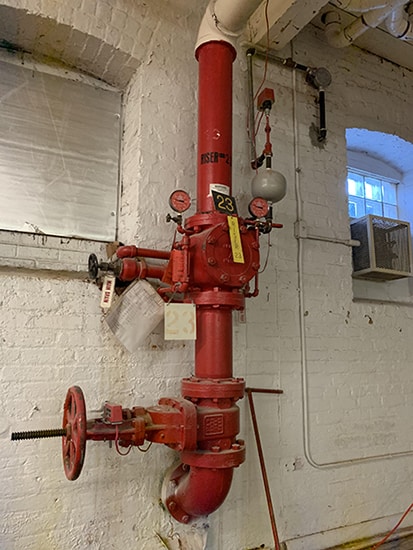
For those installing a water motor gong, note that pipes connecting to it must be at least 3/4” and corrosion-resistant (16.11.1.3). For contractors going with an electronic fire bell, note that most fire bells installed with local waterflow alarms are roughly 120 volts AC, with electricity delivered through a fire sprinkler flow switch.
One final note: signs are recommended (but not required) when there’s no fire alarm system in the building. The 2019 edition of NFPA 13 recommends that signs reading “SPRINKLER FIRE ALARM: WHEN BELL RINGS CALL FIRE DEPARTMENT or POLICE” be installed next to the bell or gong in a highly visible location.
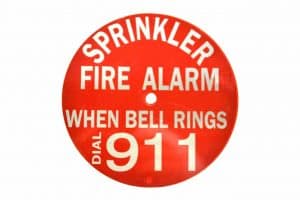
Low-voltage DC bells are used with fire alarm systems, with quantity varying with the size of the room
Devices connected to fire alarm control panels typically rely on DC, or direct current, power. They’re also typically low-voltage, running at 24 or even 12 volts. While the panels themselves connect to standard 120-volt AC sources, the energy delivered from the panel to notification appliances downstream is of the low-voltage variety.
When coupled with a fire alarm system, fire alarm bells serve as occupant notification devices—audible and/or visual signals that facilitate evacuation. Under NFPA 72: National Fire Alarm and Signaling Code, all audible notification devices must:
-
Be listed (18.3.1).
-
Have a nameplate with their electrical requirements and select installation rules (18.3.2).
-
Protected against any damage they may face with listed guards or covers (18.3.4).
-
Never cause ambient sound levels to exceed 110 decibels, even when all bells, horns, or other devices are active (18.4.1.2).
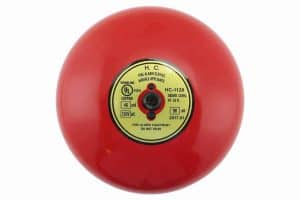
These devices sound one of three signal types: public mode audible, private mode audible, and sleeping area. All must be louder than the average ambient sound level or the maximum sound level having a duration of at least 60 seconds (whichever is greater). Sections 18.4.3, 18.4.4, and 18.5.5 prescribe these sound levels depending on the device’s location and use:
- Public mode (notifying everyone in an area): +15dB over average ambient or +5db over maximum (measured 5 feet above the floor)
- Private mode (notifying staff tasked with evacuating a building’s occupants): +10dB over average ambient or +5dB over maximum (measured 5 feet above the floor)
- Sleeping area (waking sleeping residents): +15 dB over average ambient, +5dB over maximum, or 75dB (measured at “pillow level”
It’s up to installers to measure or properly estimate average and maximum sound levels. But from these levels, it’s possible to determine how many bells are required—and how loud each one needs to be. As we explained earlier, listeners experience a 6-decibel decrease for each doubling of distance. In a sleeping area—where the required levels may be as low as 75dB—a 96-decibel fire bell may be audible from more than 100 feet in any direction.
Still, as noise levels increase, the fire bell is effective over a reduced range. The simplest fix may be to select a louder device. A 105-decibel bell can provide 90 dB of sound from more than 55 feet away—more than double the distance of a 96-decibel appliance.
Alternatively, contractors can provide more fire bells, so long as they keep in mind that each added bell will increase these levels only slightly. Imagine a 20-foot by 20-foot room. To reach 105 decibels of sound at the center (10 feet away from the walls), you’d need:
- One bell at 105 dB
- More than 3 at 100 dB
- More than 9 at 95dB
While there are other factors to consider here—including a building’s acoustics—it’s worth remembering that one bell with the right decibel rating can do the job of ten bells.
There’s plenty to know about fire safety electronics—so keep on reading
Want to learn more about the requirements surrounding fire bells? Check out these other guides from our Thoughts on Fire blog, including:
- Fire bell mounting height in fire alarm systems
- Placing and protecting waterflow alarm bells in compliance with NFPA 13
- Installing a fire bell
- Understanding initiation, occupant notification, and monitoring
- Alarm system requirements for residential, healthcare, and daycare facilities
- Fire alarm system requirements for educational, commercial, and other occupancies
- How fire alarm control panels work
You can also browse our full catalog of fire alarm bells and accessories, flow and pressure switches, and “CALL 911” signs.
Questions? Call us at +1 (888) 361-6662 or email support@qrfs.com.
This blog was originally posted at blog.qrfs.com. If this article helped you, check us out at Facebook.com/QuickResponseFireSupply or on Twitter @QuickResponseFS.


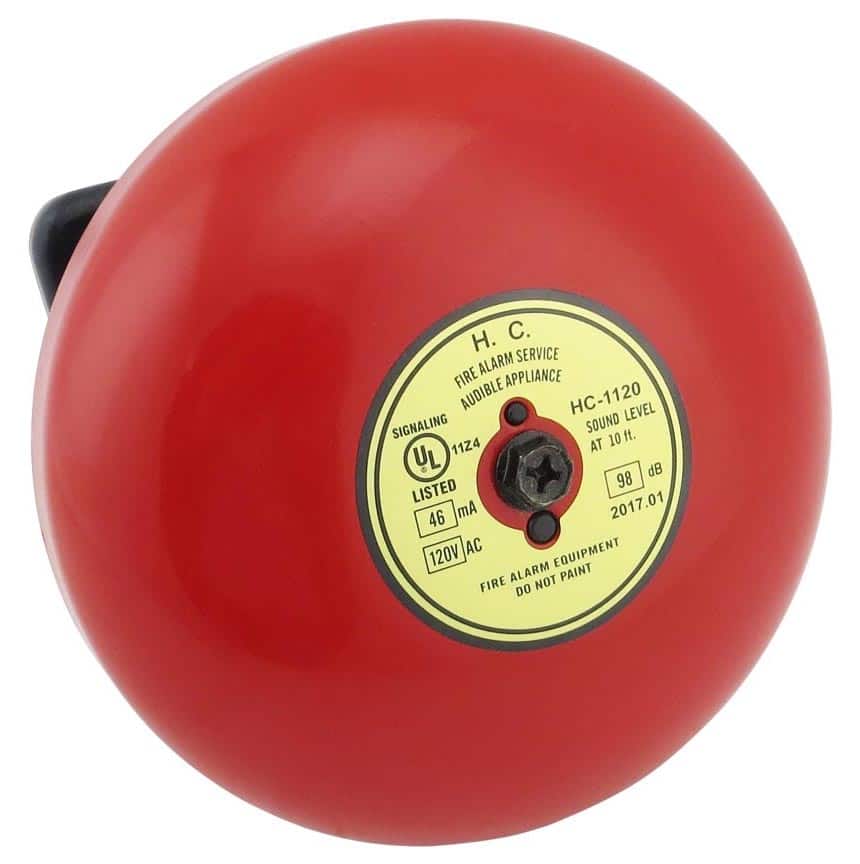

Regarding an exterior fire bell notification, at a Water Treatment Plant in the city of Hollywood, is it allowed by the local code (Municode)?
I would appreciate your input.
I am a project engineer in Broward.
Thank you
Jorge— Thanks for reaching out. For code questions like this, we recommend submitting your question through QRFS Ask A Pro. Click the link to submit your question with some information about your building or system, and a fire protection professional will provide a detailed answer based on standards and codes. Our pros include AHJs, contractors, engineers, and code experts with 150+ years of combined experience!